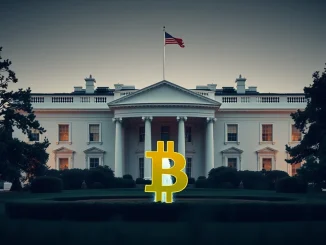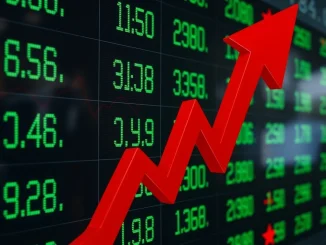
Hold onto your hats, folks! The economic landscape just got a whole lot more interesting. In a move that’s sending ripples through global markets, former President Donald Trump has confirmed the implementation of 25% tariffs on goods from Canada and Mexico. This isn’t just a minor trade tweak; it’s a significant policy shift that could have far-reaching consequences. Let’s dive into what this means and why it matters, especially in our fast-paced world of finance and digital assets.
Trump Tariffs Confirmed: What’s the Deal?
According to a recent update from Watcher Guru on X (formerly Twitter), President Trump has officially announced that these 25% tariffs will take effect after March 4th. This decision follows a previous extension, initially intended to provide time to address ongoing border security concerns. But now, the clock has run out, and the tariffs are set to become reality.
- The Trigger: Border security concerns were cited as the primary reason for initially considering these tariffs.
- The Extension: A temporary extension was granted to allow for discussions and potential resolutions on border security.
- The Deadline: March 4th marks the end of the extension, and the tariffs are now confirmed to proceed.
- The Source: The announcement was highlighted by Watcher Guru, a well-known source for market and financial news, on social media platform X.
It’s important to note that while the stated reason is border security, the economic implications are front and center. For those in the crypto space, any major economic policy shift can create volatility and opportunities. Are we about to see a flight to alternative assets as traditional markets react?
“Extremely Liquid and Rich Again”: The Promise of a Boost to the US Economy
President Trump’s statement, as reported by Watcher Guru, emphasizes a significant potential upside for the United States. He believes these US economy-focused tariffs will be a boon, declaring they will make the country “extremely liquid and rich again.” This bold claim hinges on the idea that tariffs will incentivize domestic production and reduce reliance on imports from Canada and Mexico.
| Potential Benefits for the US Economy (According to Trump’s Stance) | Possible Mechanisms |
| Increased Domestic Production | Higher import costs due to tariffs make domestically produced goods more competitive. |
| Revenue Generation | Tariffs themselves generate revenue for the US government. |
| Job Creation | Increased domestic production could lead to more manufacturing jobs within the US. |
| Reduced Trade Deficit | Lower imports from Canada and Mexico could help shrink the trade deficit. |
However, the economic reality of tariffs is rarely straightforward. While proponents highlight potential benefits, economists often point to a range of potential downsides. What are some of the challenges and counterarguments to consider?
Navigating the Looming Trade War: Potential Challenges and Ripple Effects
The imposition of tariffs can often be seen as the opening salvo in a potential trade war. While the aim might be to bolster the US economy, the reality can be far more complex and potentially damaging. Here are some of the key challenges and negative consequences that economists and trade experts often highlight:
- Increased Consumer Prices: Tariffs are essentially taxes on imports. These costs are often passed down to consumers in the form of higher prices for goods.
- Retaliatory Tariffs: Canada and Mexico, and potentially other trading partners, may retaliate by imposing their own tariffs on US goods. This tit-for-tat escalation can harm businesses on all sides.
- Supply Chain Disruptions: Modern economies rely on complex global supply chains. Tariffs can disrupt these chains, leading to inefficiencies and increased costs for businesses.
- Reduced Competitiveness: If US businesses face higher costs for imported components or raw materials due to tariffs, their competitiveness in the global market could be diminished.
- Damage to International Relations: Tariffs can strain relationships with key trading partners, impacting diplomatic and economic ties beyond just trade.
For the cryptocurrency market, global economic uncertainty often translates into volatility. Traders and investors will be closely watching how these Trump tariffs unfold and the reactions from Canada and Mexico.
Impact on Canada and Mexico: Key Trading Partners in the Crosshairs
The 25% tariffs directly target Canada Mexico tariffs, two of the United States’ largest trading partners. The economic relationship between these three nations is deeply intertwined, particularly under agreements like the USMCA (United States-Mexico-Canada Agreement, formerly NAFTA). Significant tariffs could disrupt this established trade flow and have considerable economic repercussions for both Canada and Mexico.
| Potential Impacts on Canada and Mexico | Examples and Considerations |
| Reduced Exports to the US | Higher tariffs make Canadian and Mexican goods more expensive in the US market, potentially decreasing demand. |
| Economic Slowdown | Reduced exports can lead to slower economic growth in Canada and Mexico, impacting various sectors. |
| Job Losses | Industries heavily reliant on exports to the US could face job losses if demand decreases. |
| Retaliatory Measures | As mentioned, retaliatory tariffs from Canada and Mexico are a strong possibility, further escalating trade tensions. |
The interconnected nature of global trade means that these tariffs won’t just be isolated to North America. The shockwaves could be felt across the world, impacting supply chains, investment decisions, and overall economic sentiment.
Actionable Insights: What Does This Mean for You?
While the specifics of these tariffs are still unfolding, here are some actionable insights to consider, particularly for those involved in or observing the cryptocurrency and financial markets:
- Monitor Market Volatility: Expect potential increased volatility in both traditional and cryptocurrency markets as the tariff situation develops.
- Diversify Your Portfolio: In times of economic uncertainty, diversification across different asset classes can be a prudent strategy.
- Stay Informed: Keep up-to-date with news and analysis regarding trade policy and its potential economic impacts.
- Consider Safe-Haven Assets: In periods of economic turbulence, some investors may seek refuge in assets perceived as safe havens, which can sometimes include cryptocurrencies like Bitcoin.
- Long-Term Perspective: Remember that economic cycles and trade policies are dynamic. Maintain a long-term perspective and avoid making rash decisions based on short-term market fluctuations.
In Conclusion: Navigating the Tariff Terrain
President Trump’s confirmation of 25% tariffs on Canada and Mexico is a significant development with potentially wide-ranging economic consequences. While the stated aim is to benefit the US economy, the reality of tariffs is often complex, with potential downsides including increased consumer prices, retaliatory measures, and disruptions to global trade. For those in the cryptocurrency space, this situation underscores the interconnectedness of global finance and the potential for economic policy shifts to create both challenges and opportunities. Staying informed, prepared, and adaptable will be key to navigating these turbulent economic times.



